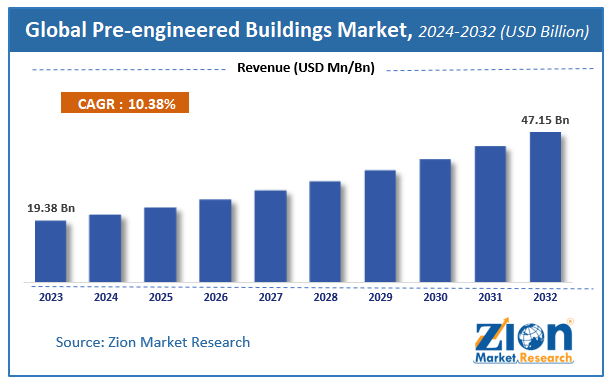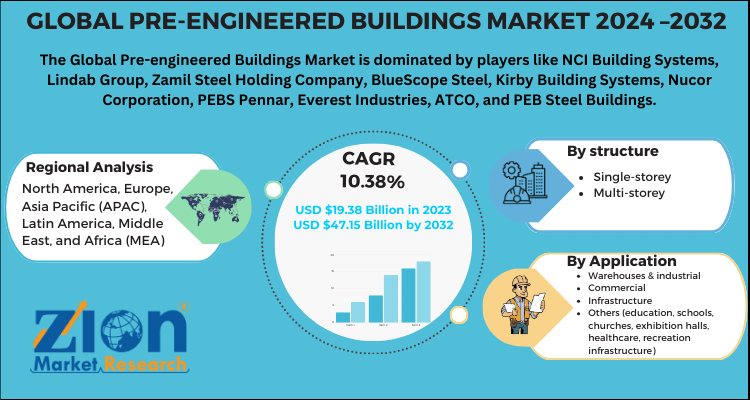Pre-engineered Buildings Market Size, Share, Trends, Growth and Forecast 2032

Pre-engineered Buildings Market- By Application (Infrastructure, Warehouses & Industrial, and Commercial), By Structure (Multi-storey and Single-storey), and Region - Global Industry Perspective, Comprehensive Analysis, and Forecast, 2024 - 2032
| Market Size in 2023 | Market Forecast in 2032 | CAGR (in %) | Base Year |
|---|---|---|---|
| USD 19.38 Billion | USD 47.15 Billion | 10.38% | 2023 |
Pre-engineered Buildings Market Insights
According to Zion Market Research, the global Pre-engineered Buildings Market was worth USD 19.38 Billion in 2023. The market is forecast to reach USD 47.15 Billion by 2032, growing at a compound annual growth rate (CAGR) of 10.38% during the forecast period 2024-2032. The report offers a comprehensive analysis of the market, highlighting the factors that will determine growth, potential challenges, and opportunities that could emerge in the Pre-engineered Buildings industry over the next decade.
Introduction
Pre-engineered constructions are designed by pre-engineered building manufacturer by utilization of raw materials available through various sources and manufacturing techniques proficiently fulfilling a myriad range of aesthetic & structural designs. Furthermore, these constructions are also termed as pre-engineered metal constructions and is becoming common as a result of minimized proportion of pre-engineering activities including customized computed aided designs or simply engineered metal constructions. In 1960, standardized engineering design for constructions were first advertised as pre-engineered buildings.
The Pre Engineered Buildings (PEB) Market refers to the fabrication of buildings using a systematic approach, where structural components are manufactured in a factory and then assembled on-site. These buildings are designed to meet specific structural and aesthetic requirements, offering advantages such as cost-effectiveness, faster construction times, and flexibility in design.
Global Pre Engineered Buildings Market Drivers
The market drivers for the Pre Engineered Buildings Market can be influenced by various factors. These may include:
- Fast Urbanization and Industrialization: As these two trends continue to pick up speed on a worldwide scale, there is an increasing need for affordable, quickly constructed buildings. Pre-engineered structures may be constructed more quickly than traditional buildings, which makes them perfect for addressing the demands of industries and urban regions that are experiencing significant growth.
- Cost-Effectiveness: Because pre-engineered structures require less time to construct, waste less material, and pay less labor, they are frequently more affordable than traditional buildings. Adoption of PEBs is greatly influenced by their cost-effectiveness, particularly in emerging markets and financially constrained businesses.
- Flexibility and Customization: It is now simpler to modify pre-engineered buildings to meet unique needs thanks to developments in design and manufacturing technologies. A wider range of styles, sizes, and combinations are available to customers, giving them more flexibility to fulfill their specific demands. The option to customize is especially appealing to industries like manufacturing facilities, warehouses, and commercial complexes that have specific architectural requirements.
- Sustainability and Environmental Concerns: In keeping with the growing emphasis on environmental sustainability, pre-engineered buildings can be created with energy-efficient features and sustainable materials. Environmentally concerned clients and regulatory organizations find PEB construction to be a desirable alternative due to their effective use of materials, which also helps limit waste and lower the building process’ overall environmental footprint.
- Technological Developments: The quality, effectiveness, and adaptability of pre-engineered building systems have increased due to continuous developments in engineering, design software, and production techniques. PEBs are being adopted by a wide range of industries and applications due to the faster design iterations, enhanced structural integrity, and increased manufacturing precision made possible by these technical advancements.
- Government Policies, Incentives, and laws: The demand for pre-engineered buildings can be greatly impacted by government policies, incentives, and laws pertaining to infrastructure development and construction. The use of sustainable or energy-efficient building solutions may be encouraged by local governments in the form of tax breaks or other incentives, which may increase the uptake of PEBs. Pre-engineered building systems may also be preferred in design and construction due to laws pertaining to building codes, safety standards, and environmental considerations.
- Infrastructure Development Projects: In order to satisfy strict schedules and financial limitations, fast-track construction solutions are frequently needed for large-scale infrastructure development projects including stadiums, seaports, airports, and commercial complexes. For these kinds of projects, pre-engineered buildings provide a workable solution that allows for quick construction and economical deployment of infrastructural assets.
Global Pre Engineered Buildings Market Restraints
Several factors can act as restraints or challenges for the Pre Engineered Buildings Market. These may include
- High upfront Investment: The design, engineering, construction, and installation of pre-engineered buildings come with a hefty upfront cost. Potential customers may be discouraged by this large upfront cost, especially smaller companies or those with tighter budgets.
- Limited Customization: Although pre-engineered structures are efficient and reasonably priced for many uses, they might not be appropriate for projects needing specially designed architecture or highly customized designs. This restriction may limit market potential, particularly in industries where aesthetics are highly valued.
- Perception Challenges: Pre-engineered structures could be seen by some prospective buyers as being of lower quality than buildings constructed using traditional methods. Spreading awareness of PEBs’ advantages, robustness, and adaptability in the market can be difficult and could impede its uptake.
- Regulatory Compliance: For pre-engineered building projects, adhering to local building codes, zoning laws, and environmental standards may provide difficulties. Complying with various regulatory regulations in several locations increases complexity and may cause delays in project completion dates.
- Competition from Conventional Construction: Certain market categories are still dominated by traditional construction techniques, such as brick and mortar buildings. It is necessary to present the benefits of pre-engineered structures in terms of cost, construction speed, and sustainability in order to persuade clients to convert.
- Supply Chain Disruptions: The availability and price of raw materials required for pre-engineered buildings might be affected by supply chain disruptions brought on by trade disputes, natural catastrophes, or other events. Such hiccups may result in project delays and higher costs.
- Limited Knowledge in Developing countries: Pre-engineered buildings may not be well known in certain developing countries. To promote the advantages and uses of PEBs, businesses operating in these areas might need to make significant investments in marketing and educational initiatives.
- Sensitivity to Economic Cycles: Changes in the economy have an impact on the pre-engineered building market. Businesses may decide to halt or postpone construction projects during economic downturns, which will decrease the market for pre-engineered buildings.
Market Growth Dynamics
Escalating green construction demand and necessity of minimizing construction cost will steer the growth of pre-engineered buildings industry over the forecast period. Apart from this, huge preference for lightweight buildings will enhance the market trends over the coming years. In addition to this, pre-engineered constructions offer advantages including reduced maintenance charges, quality control, architectural versatility, and power-efficient walls as well as roofing.
Furthermore, swift industrialization witnessed in emerging economies like Brazil, India, and China are anticipated to enlarge the scope of the market over the years to come. Favorable government schemes for constructing green buildings will offer new growth avenues for the industry over the ensuing years.
Asia Pacific Market To Register Massive Growth Over 2024-2032
The growth of the regional market over the forecast period is owing to escalating popularity of pre-engineered constructions in the countries like India and China. Furthermore, surging population, huge government funding, and demand for low-cost green construction will elevate the growth graph of pre-engineered buildings industry in the Asia Pacific zone over the forecasting years.
Pre-engineered Buildings Market: Report Scope
| Report Attributes | Report Details |
|---|---|
| Report Name | Pre-engineered Buildings Market |
| Market Size in 2023 | USD 19.38 Billion |
| Market Forecast in 2032 | USD 47.15 Billion |
| Growth Rate | CAGR of 10.38% |
| Number of Pages | 110 |
| Key Companies Covered | NCI Building Systems, Lindab Group, Zamil Steel Holding Company, BlueScope Steel, Kirby Building Systems, Nucor Corporation, PEBS Pennar, Everest Industries, ATCO, and PEB Steel Buildings |
| Segments Covered | By Structure, By Application And By Region |
| Regions Covered | North America, Europe, Asia Pacific (APAC), Latin America, Middle East, and Africa (MEA) |
| Base Year | 2023 |
| Historical Year | 2018 to 2022 |
| Forecast Year | 2024 - 2032 |
| Customization Scope | Avail customized purchase options to meet your exact research needs. Request For Customization |
Moreover, huge foreign direct investments for aiding the setting up of distribution centers & manufacturing units to scale up the production capacity in the Asia Pacific region will boost the market expansion in the region.
Key players profiled in the report include-
- NCI Building Systems
- Lindab Group
- Zamil Steel Holding Company
- BlueScope Steel
- Kirby Building Systems
- Nucor Corporation
- PEBS Pennar
- Everest Industries
- ATCO
- PEB Steel Buildings.
The global pre-engineered buildings market is segmented as follows:
By structure
- Single-storey
- Multi-storey
By application
- Warehouses & industrial
- Commercial
- Infrastructure
- Others (education, schools, churches, exhibition halls, healthcare, recreation infrastructure)
By Region
- North America
- The U.S.
- Canada
- Europe
- France
- The UK
- Spain
- Germany
- Italy
- Rest of Europe
- Asia Pacific
- China
- Japan
- India
- South Korea
- Southeast Asia
- Rest of Asia Pacific
- Latin America
- Brazil
- Mexico
- Rest of Latin America
- Middle East & Africa
- GCC
- South Africa
- Rest of Middle East & Africa
Table Of Content
Methodology
Choose License Type
List of Contents
Pre-engineered Buildings Market InsightsIntroductionGlobal Pre Engineered Buildings Market DriversGlobal Pre Engineered Buildings Market RestraintsMarket Growth DynamicsAsia Pacific Market To Register Massive Growth Over 2024-2032Pre-engineered Buildings Report ScopeThe global pre-engineered buildings market is segmented as follows:RelatedNews
HappyClients
Zion Market Research
Tel: +1 (302) 444-0166
USA/Canada Toll Free No.+1 (855) 465-4651
3rd Floor,
Mrunal Paradise, Opp Maharaja Hotel,
Pimple Gurav, Pune 411061,
Maharashtra, India
Phone No +91 7768 006 007, +91 7768 006 008
US OFFICE NO +1 (302) 444-0166
US/CAN TOLL FREE +1 (855) 465-4651
Email: sales@zionmarketresearch.com
We have secured system to process your transaction.
Our support available to help you 24 hours a day, five days a week.
Monday - Friday: 9AM - 6PM
Saturday - Sunday: Closed







